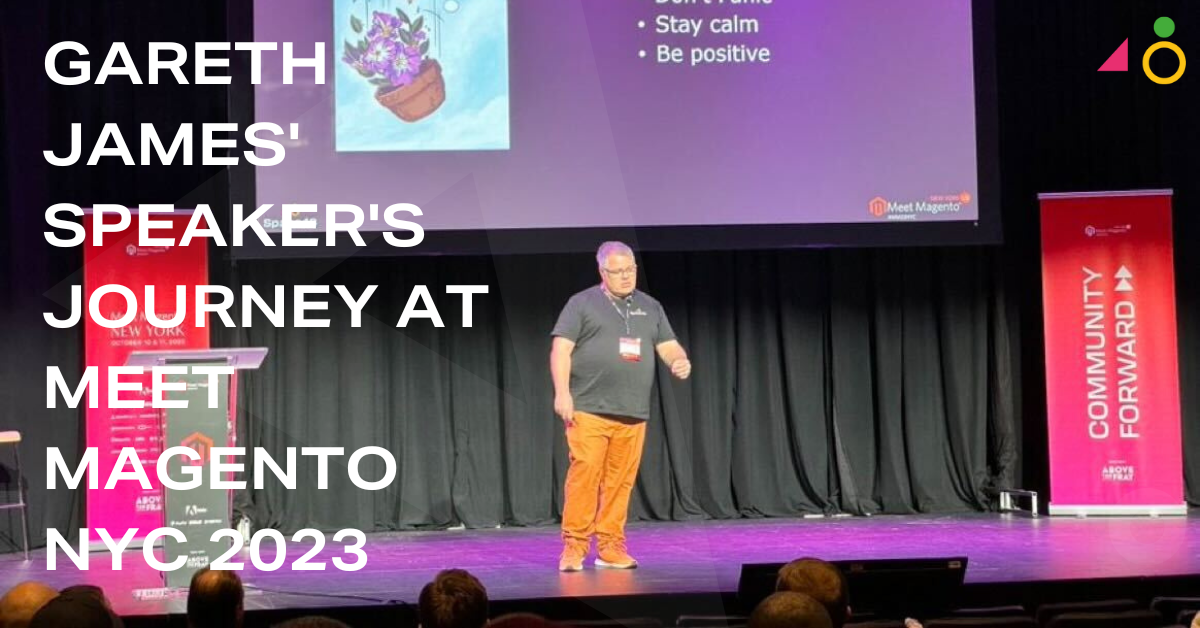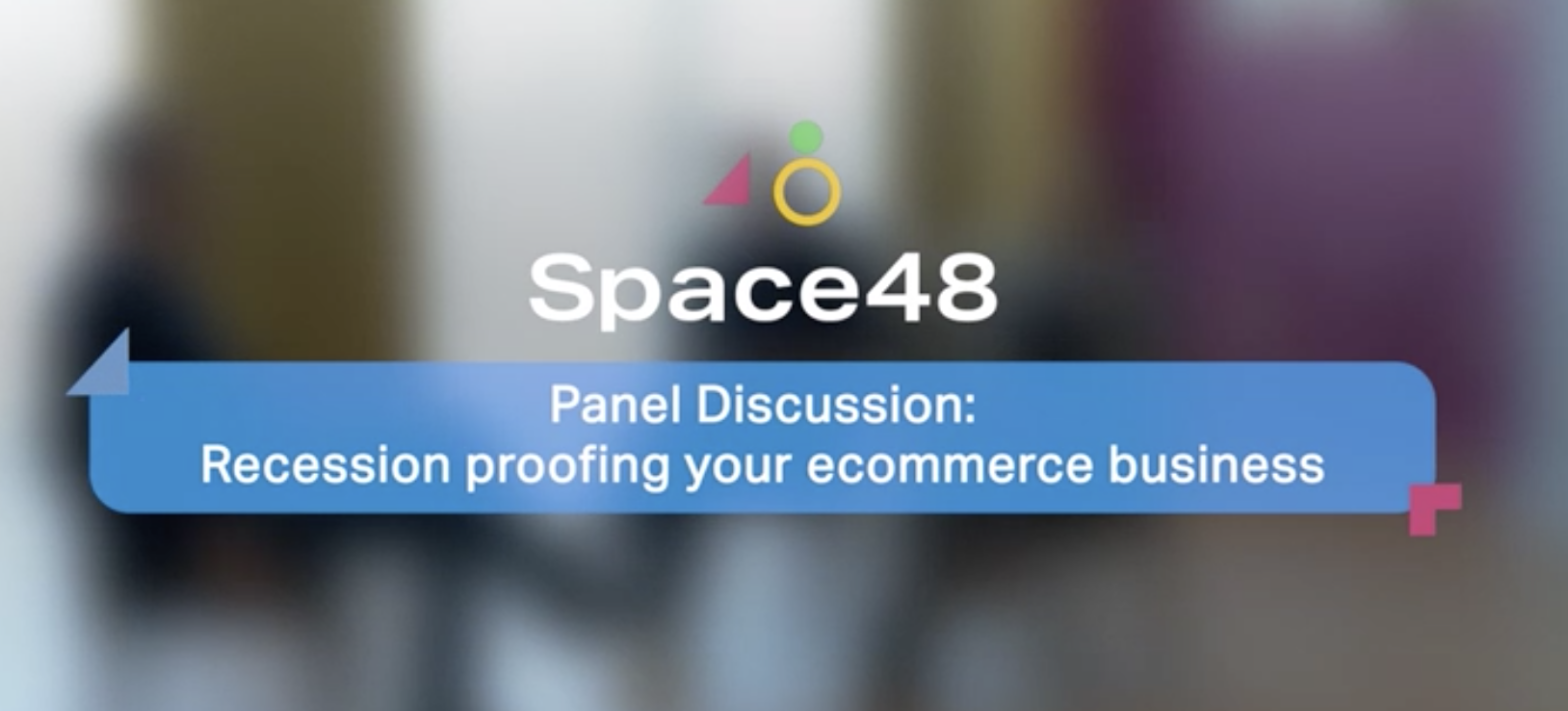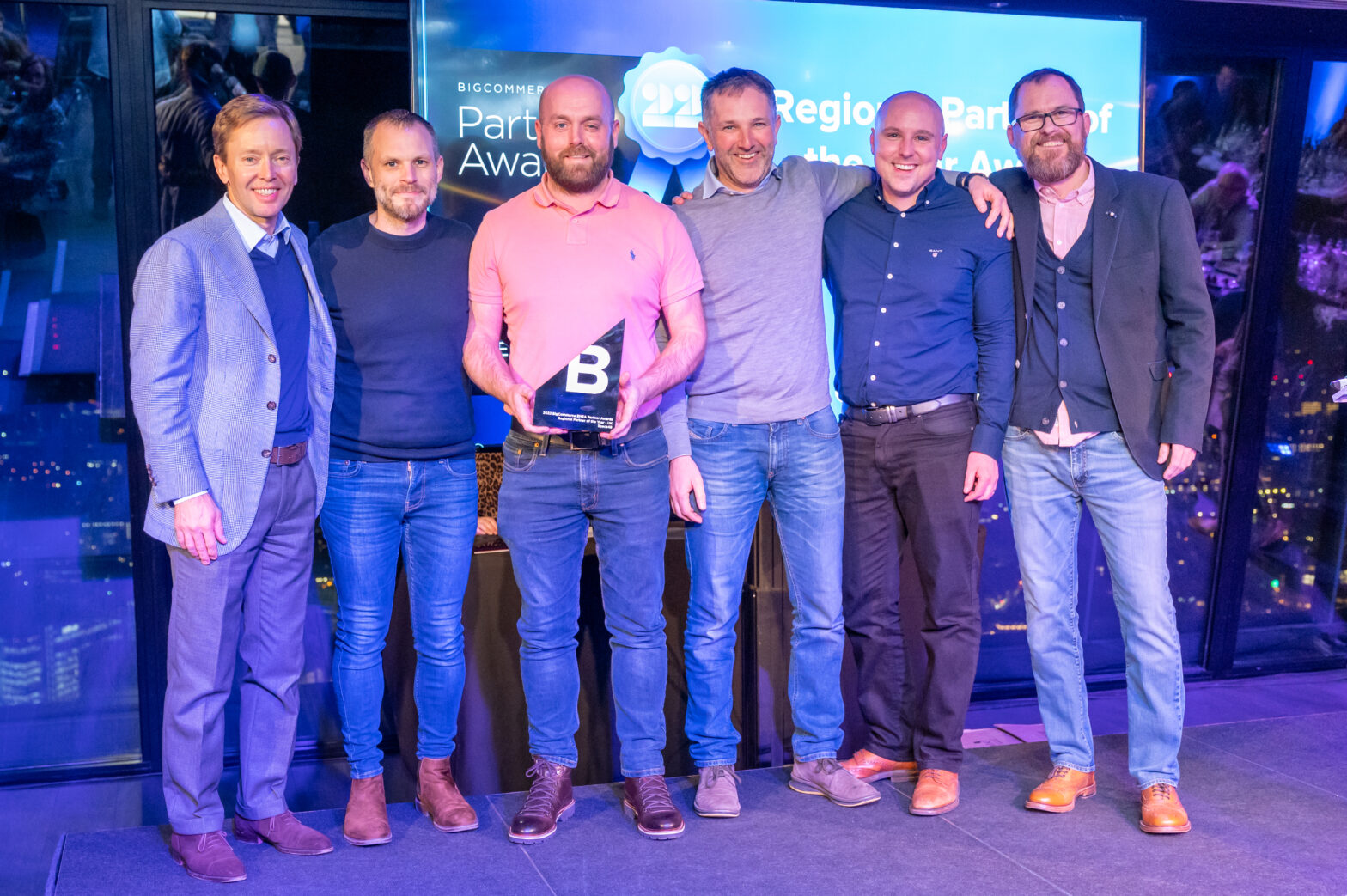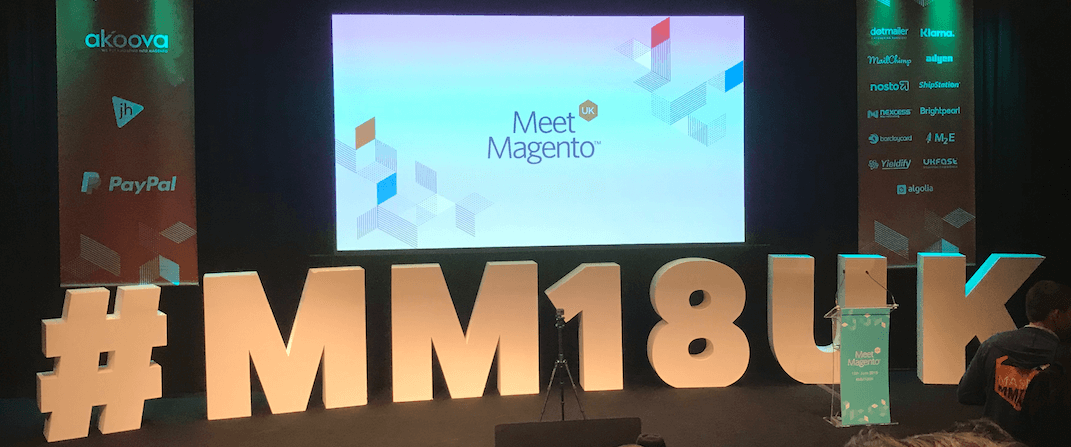
June 19, 2018
All Aboard the Innovation Train at Meet Magento UK 2018
The 13th June saw the first major Magento conference since the announcement of Adobe’s acquisition of the leading ecommerce platform, and the mood was really positive.
The tone was set early on with Peter Sheldon, the VP of Strategy at Magento. He painted the picture of the state of a customer’s commerce journey and all of the opportunities that brands have to create and craft the customer experience. Using the example of Tesla, Peter named “experience” as the primary differentiator of those brands which are going to stand the test of time. It will be those that invent the future, not those that dominate the present.
What investors look for in great ecommerce businesses
Leon Hughes from Piper spoke from the perspective of an investment company and what they look for in ecommerce businesses. It was hugely valuable to have recommendations from outside the technology or solution partner space and for it to come from someone financially motivated to be working with high-potential, high-growth businesses.
Leon’s talk took us through the different aspects of the business, i.e consumer, tech, touch-points and KPIs, with some examples of what success looks like. While there are many facets of the business, the ability for merchants to have a single customer view is critical and is differentiating business as it facilitates excellence. It enables the provision of superior customer service, more insightful business analytics and reporting, and also demonstrates that investment and capabilities of the underlying technology and IT systems within the business.
The market-leading customers, Leon found, were investing in experience further than other merchants, such as the customer post-purchase flow. One example he gave was of a merchant pro-actively monitoring Royal Mail parcel tracking and if they predicted that an order was going to be late, they proactively email the customer, provided a refund and offered another complimentary item. Now that’s a commitment to experience that actually rivals that of Amazon Prime!
A simpler top-tip for post-purchase customer experience that merchants can put into practice with a smaller investment is segmenting order confirmation emails so that they’re worded differently for new customers, repeat customers and VIP customers. It’s a shame that most confirmation emails right now don’t acknowledge the pre-existing relationship between customer and merchant.
In terms of KPIs, there are no globally-applicable standards as merchant business models and verticals vary but Leon did say that successful businesses typically have a 40% customer retention rate, i.e. 2 or more orders over a 12-month period. With his insights from having worked with a range of businesses, Leon found that that the shorter the time between the first and second order, the greater change that customers will come back in the longer term. Another takeaway was that customer retention and the resulting effect on customer lifetime value suggested that merchants should be spending at least 25% of customer initial spend on their acquisition.
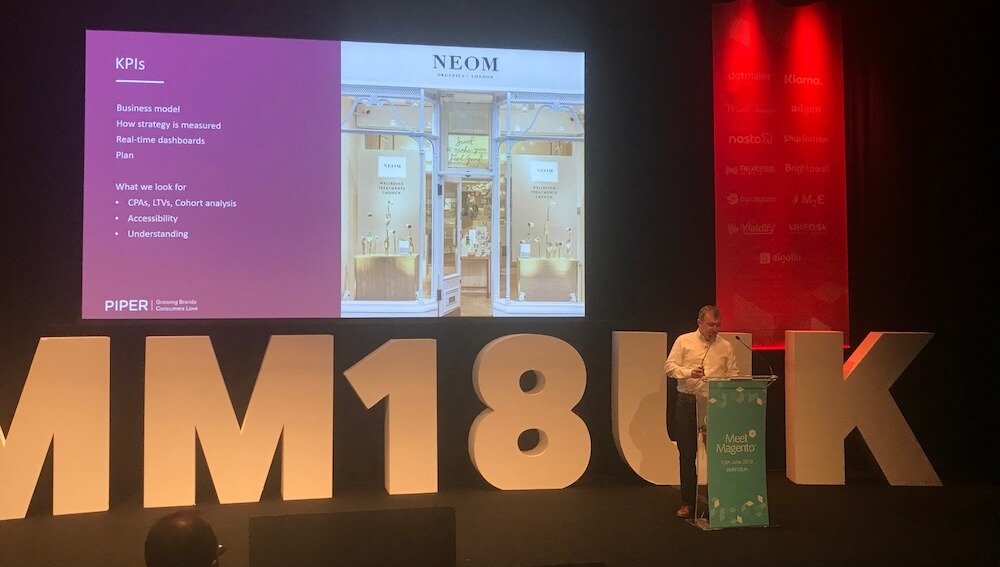
The technical track
I spent most of the time in the merchant track this time around, as I found value in every single talk I attended! Although there was a great line-up in the technical track as well.
Progressive Web Apps represent the pinnacle of what can be achieved on the web right now, so it’s understandable that they dominated conversations in this track. We also had a talk from Dave Macaulay on the upcoming Magento PageBuilder tool for creating page designs without the need for developers. This is currently earmarked for release as part of Magento 2.3 later in the year, for Commerce edition, but is also expected to be released on the Magento Marketplace as a paid extension.
In terms of PWAs, we had a broad range of experts sharing. There was Shane Osbourne of JH on how to make PWAs fast now. We also had a panel where each member had experience creating their own PWA platform: Front Commerce, VueStorefront and Deity. Finally, we also had Rowan, a developer advocate from Google, share some example use cases for PWAs. If you’re interested in hearing more from Rowan prior to videos being released, I really recommend his Google I/O talk on AMP and PWA:
Conducting user research
We were privileged to have Danielle Mundle, a UX research consultant from the US over at the event to make conducting research more approachable for merchants.
Once you set some time aside for user research, you’re likely to find that there are a number of good ideas to test that you can gather from the team without needing to get help from a consultancy. There are a number of tools to help run user tests such as Validately, Loop11 and FullStory. When surveying customers, be careful to design your questions so they aren’t leading questions or give away what you’re testing for. You want to build rapport and trust with users so that they’re confident to share their real experiences.
However, whether using surveys or analytics, it’s easy for bias to be introduced so it’s important to stay as objective as possible. That being said, reading between the lines is a powerful skill for getting at the root of what’s going on.
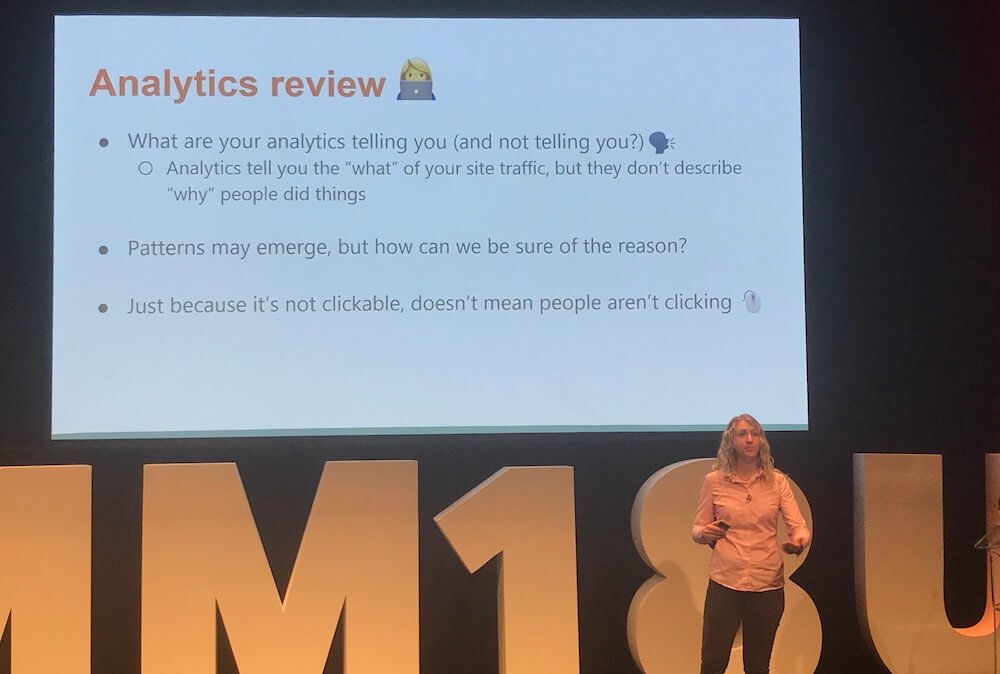
No site is perfect at launch, and every site will want continuous testing and improvements. This is true even just to stay up-to-date with a constantly moving market. So use analytics, use survey tools to try and help get to the why behind the what and focus your efforts on a measurable goal. Top tips, Danielle!
Creating an optimisation culture
This talk from Guido Jansen, Global Conversion Rate Optimisation Lead at Randstad, was nicely paired with Danielle’s. Guido took us through the challenge of kick-starting a CRO culture within an ecommerce business. It isn’t easy to get started but anything is a step in the right direction. Randstad themselves are a huge global business and last year had the grand total of zero tests but this year they set a target of 450 tests being run. And by June this has already been surpassed.
Probably the biggest challenge in the culture change is creating a safe environment for the team to experiment knowing that failing is OK. 80-90% of tests showing no positive improvements is normal! So, you have to be prepared to regularly put efforts into tests with no reward which can be demoralising. However, stick around, because the 10% of the time that it does work, it can pay for all of the “failed” tests.
Learn more about ecommerce split testing in our handy guide: Guide to Ecommerce Split Testing.
What does an innovation mindset look like?
There’s no KPI for how innovative a company is but Co-founder of BeerHawk Mark Roberts and Paul Younghusband from END Clothing did a good job of taking us through the sort of things they’ve been able to achieve in their businesses.
50% of BeerHawk’s revenue comes in the November and December period, so that puts a lot of pressure on operations. It also means that there’s a high risk on the business should something go wrong at the time, so there’s a desire for both to capitalise on it as well as smoothing sales out across the rest of the year. They’ve innovated with new marketing campaigns and products, including beer advent calendars and hosting beer festivals for the passionate customers.
End Clothing has had some of the most successful product launches that shoe-ware brands have ever seen! This is an exciting and proud achievement but it comes with its own challenges. In order to support this, the business invested in technology early on, as they recognised that having a tech team was going to be core to their business success. They invested in an office in a start-up hub of Shoreditch, in London, and built a development team. Uniquely, it’s this team that takes ownership for KPIs such as conversion rate.
The challenge with product launches is coping with so many visitors in a short space of time and downtime during this period is incredibly expensive. In addition to this, the products are so sought after that they suffer from “sneaker bots”, those that use automated tools to purchase them for their resale value. They’ve found that using micro-sites with bot filtering tools has been an effective way of handling these launches.
Particularly innovatively, they tested allowing everyone to submit their personal details and payment information and then randomly select which customers would get their orders fulfilled. They were initially nervous at how customers would receive this ordering process but it’s been welcomed. A side-effect is that it also means they have information on customers that attempted to order a pair but weren’t successful, to help further marketing campaigns.
The panel rounded off by highlighting that simply being transactional and providing a frictionless checkout isn’t the only goal when building a business. Building that brand and the engaged community around it is really important. This ties back well with comments that Leon from Piper had made earlier in the day. A community of brand advocates is an important aspect of evaluating the businesses that they invest in.
How Betty’s, a 100-year old brand, embraces digital
Recently, I’ve been keeping busy by scoping an exciting project for Bettys on Magento 2. Getting fresh cakes and chocolates to customers on time is a mission that I can get behind! So, it was great to listen to Sam Sargison, Head of Digital and Corporate at Bettys, on how the culture of the business modernises for the digital age while retaining and respecting the beauty of its 100-year heritage.
Like any business, part of what’s important here is to ensure that the brand values and essence are well understood within the business. It’s good to regularly spend some time reflecting on these and evaluating how well you’re doing against them.
For a business that has been around for 100 years, there’s a lot of tradition and experience, both internally by staff members and externally from customers. At the same time, the way people engage with the brand has changed and continues to. When surveying customers, they need to take into account who they’re speaking to. Many may have grown up visiting a tea room with, say, their grandmother, but now may mainly order online when gifting. Both will say that they’ve visited a tea room but this doesn’t uncover how people are interacting with the brand more recently. This ties back into the Danielle Mundle’s talk on carefully wording customer survey questions to maximise the value, as ultimately they’re going to affect the direction of the business.
While the heritage has made embracing digital a little more difficult, they benefit from having been through lots of learning experiences. They know how to manage subscription models, they have a letterbox-friendly range and are uniquely positioned to have a memory hub and offer personalised cakes because their customer relationship has gone on for so long.
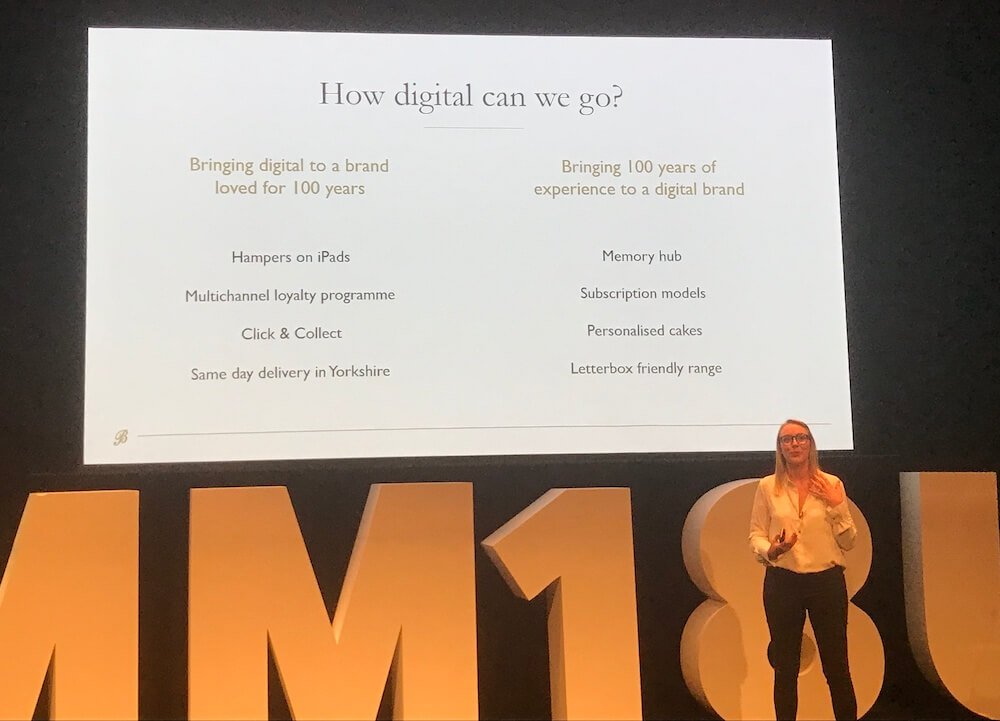
Congratulations to what Betty’s have been able to do to date and here’s to the next 100 years!
What’s killing retail?
Ask someone what’s killing retail and they’ll likely reel off a list of reasons, with Amazon fairly near the top. Suzannah Taggart, Head of E-Commerce at Gift Universe Group was on hand to force us to question that somewhat lazy response. There are always examples of brands that have failed to do well, despite on paper looking like they should be able to compete.
Gift Universe has suffered from many of the typical struggles in ecommerce, such as a lack of product exclusivity, rarely being the cheapest, poor online-sales and poor in-store experience. However, a concerted effort to turn things around by being more innovative and by questioning why things are done a certain way, has made a massive impact on their business. It’s now a business which has aligned its branding and pricing on all channels, finally connecting and tracking the customer experience through all channels, including online and in-store. Also, rather than set up some coordinated marketing campaign from head office, they make the most of the creativity and passion of their workers in stores to create fun content on social media.
Summary
For a single day event, there was lots of great business and technical content. So if you didn’t make it, be sure to keep an eye on the Meet Magento UK site and its official Twitter account for slides and video availability. If I read between the lines of the day’s talks, I’d say that while there’s no shortage of challenges for merchants to face, there are so many positive stories that show how innovation, tenacity and smart work can revolutionise even the most static of businesses. While there’s a lot of change in the sector, those that seek out that change have the best chance of sticking around to tell the tale!
Many thanks to our friends at JH for taking over the reins of this year’s UK Magento conference. They did a fantastic job of hosting us. Same time next year? In the meantime, sign up to Magento Live Europe and take some time to work on the business rather than in the business.
Magento continues to lead the way with innovation and community support. If you’re considering upgrading to Magento 2, take a look a the results we achieved in our award-winning Magento 2 replatforming project for Cox & Cox. Or why not book a free consultation with Magento development specialist now?
{{cta(‘958954c7-8546-40b1-89bd-5cc3c978f805’)}}
Space 48 is a leading UK ecommerce consultancy, based in Manchester, specialising in website development for Magento and Shopware platforms. Get in touch with our ecommerce specialists. Our expert team will help you to pinpoint your biggest growth opportunities and improve your brand’s ecommerce strategy.

